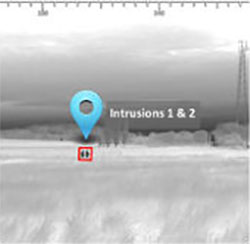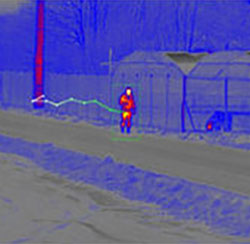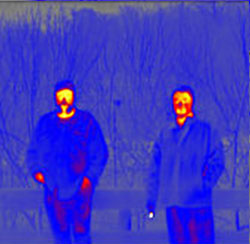Perimeter Intrusion Detection Technologies
When it comes to security, perimeter surveillance and site protection, many technologies exist including smart fences, CCTV and thermal cameras, lidar, fibre optic, radars and more. For wide area surveillance, the most common technology available is the radar. Using surveillance and security technologies to protect a site brings many benefits in terms of better situational awareness, lower cost and improved effectiveness of threat detection… But which should I choose according to my needs?
Physical Security Perimeter means physical barriers and controls that prevent or mitigate against unauthorized physical intrusions across the perimeter.
Historically used to prevent and detect intrusions in military facilities, critical infrastructure, and other high-risk sites, perimeter security solutions are now being used in many urban areas such as commercial and residential sites, retail spaces, transportation sites, etc.
There are many different technologies that are being used for perimeter protection: video surveillance systems, thermal cameras, short range radars, seismic sensors, PIR motion sensors, access control systems, alarms and notification systems, smart fencing, lighting and others.
Each security technology has its strengths and its weaknesses. The type of systems and technologies deployed will depend on the security needs of the customer. The table below highlights the main criteria to take into account when securing a perimeter.
Threat levels and needs have changed over time and companies are now investing in a reliable and efficient perimeter protection. A multi-layered protection solution is often considered which incorporates technologies together to ensure a better overall security. It’s important to put in place a unified approach to cross qualify incidents and intrusions alerts. Each layer should help delay, deter and detect intrusion. A layered approach is necessary to provide advanced warning of potential threats – before they cross a perimeter. Security must extend beyond the fence to detect, and identify threats while allowing security operators sufficient response time to protect people and facilities.
The proper implementation of any security system, requires understanding of the threat nature, possible avenues of approach, perimeter or surface to protect, sensor system performance, environmental conditions and more stringent government regulations and industry standards for perimeter security. Understanding how an intruder(s) can penetrate into your site, which highlights the potential breaches, can have a large impact on the selection, placement and operation of your system.
Many factors influence the ability of a radar to detect a target. The radar design itself, the type of target (person, vehicle), what characteristics of the target determine its measurability (size, speed), the distance from the radar to the target, the size of the target (radar cross section), the environment between the radar and the target (rain, fog) and the environment in the immediate vicinity of the target called clutter, like trees, grass, building – they all compete with the target.
A Radar (Radio Detection and Ranging) is a detection system that uses radio waves to determine the distance (range), angle, or velocity of objects.
Ground surveillance radars are based on the use of two primary technologies: Pulsed Doppler radar technology and Frequency Modulated Continuous Wave (FMCW) radar technology. Most Pulsed Doppler radars are derivatives of military radar used for wide area surveillance, while advanced FMCW radar technology was developed specifically for wide area surveillance, site security, and force protection. FMCW radars are known to provide better range resolution and more accurate target detection, while doppler radars provide extended range and coverage areas. However, due to background clutter, typical Doppler radars are unable to detect slow moving targets or a target moving across the radar beam (tangential movement).
Radar returns are typically plotted on a screen, yet they cannot identify what the target is. When paired with a pan tilt camera, radars act as target detectors cueing the cameras to focus and zoom in on the target for proper assessment and identification. The numerous blips displayed by the radar, due to a cluttered environment, force the operator to go back and forth from target to target with the PTZ to identify and prioritize the threats: he is constrained by the well-known soda straw effect induced by the long range PTZ camera.
SPYNEL is a real-time panoramic thermal imager with analytics software for automatic detection, tracking and classification of multiple threats.
Continuously rotating at up to 2 revolution/sec, Spynel provides powerful situational awareness through a 360-degree visualization of the surroundings. As a fully passive thermal sensor, it is invisible to intruders, not vulnerable to camouflage nor jamming, contrary to radar technologies.
Conversely with Spynel, panoramic detection and real time imagery come together: the operator can see the images of all the targets at once and is able to discriminate, quickly and without effort, the targets that are of interest. There is no such thing as a “lost track” because the operator keeps an eye at all times on the threats. It gives unique situation awareness capabilities.
The user-friendly Cyclope software display unburdens the operator: watching a panoramic image with instant detection&tracking of objects is much less taxing and much less prone to error than following a high number of dots and tracks on a map.
To summarize Spynel acts as a passive radar with eyes. Spynel® Series includes 10 different models split into 5 sensor families (Spynel-X, Spynel-S, Spynel-C, Spynel-U, Spynel-M) for short, medium or long-range requirements from 0m up to 9km radius.
Due to its small form factor and light weight, SPYNEL is easily mountable to a variety of surfaces including masts, poles, buildings, walls, vehicles, and more. A stable position of the SPYNEL is a key factor for successful operation.
Standard pan and tilt systems rotate but the user can only see one direction where the camera is pointing at that particular point in time. The narrow field of view (FOV) of a PTZ cause dangerous security limitations as it has no chance to automatically detect any other event in the scenery. This is known as the soda straw effect. SPYNEL IR sensor continuously rotates at up to 2 revolution/sec providing a continuous video stream from the full 360 degree FOV. This real-time video stream allows the user to view and monitor an entire perimeter at all times as well as to detect and track multiple threats simultaneously.
Advantages of thermal imaging technology are numerous for perimeter surveillance of large installations such as an airport.
Ground surveillance radars are based on specific emissions of electromagnetic waves to detect objects. Such radars are especially sensitive to interferences which can be generated by high perimeter fences or grids. As an active technology, radars can also disturb the other surveillance sensors used on site like the air traffic management radars. With its passive technology, SPYNEL 360 infrared imaging camera detects and tracks an unlimited number of threats in real-time over the full panorama. It guarantees that no event is missed. The combination of early warning, exceptional situational awareness and automatic alarms ensure a high level of protection of the installation.
Regarding the infrastructure required, SPYNEL can be easily installed on an existing pylon, building, terminal or even the control tower. Installed in height, SPYNEL takes advantage of the full 360 ° to scan the scenery and is not be disturbed by potential obstacles. Conversely some radars cannot be installed on tower higher than 3m because they are disturbed by reflection on the ground.
Another advantage of panoramic thermal imaging technology is the replay feature. All tracks are recorded and can be used as evidence for authorities.
Finally with the variety of increasingly complex threats and especially drone attacks, SPYNEL with its large field of view can detect both land and air threats which is not possible with ground surveillance radar.
Detection, Recognition, Identification - DRI
The question the most frequently asked to thermal imager manufacturers is certainly: how far can the IR camera detect a target? It is indeed a good criterion to qualify one sensor from another considering the final application. And the answer given to this question will probably include the “DRI ranges” expression.
DRI stands for Detection, Recognition and Identification. DRI ranges, expressed in km (or miles), can be found in the specification table of infrared camera brochures. In order to select the right sensor meeting the application requirements, these DRI ranges have to be, first, perfectly defined, but also assessed with regards to globally adopted industrial standards.
John Johnson, a scientist from the Army Night Vision Laboratory, was a pioneer in 1958, conducting experiments to test observers’ ability to identify targets through analog sensors. The terms “Detection”, “Recognition” and “Identification” were defined as follow:
- Detection: ability to distinguish an object from the background
- Recognition: ability to classify the object class (animal, human, vehicle, boat …)
- Identification: ability to describe the object in details (a man with a hat, a deer, a Jeep …)
The following pictures illustrate these definitions:

Detection: At several kms, two targets are detected out of the background

Recognition: A human is walking along the fence

Identification: Two males with trousers and jackets are identified, one is smoking.
Johnson defined thresholds, known as the Johnson criteria, as the minimum number of line pairs to detect, recognize or identify targets captured by scene imagers. The DRI lower limits, according to the Johnson criteria are typically in the following range:
- Detection limit: [0.75 / 1] lp
- Recognition limit: [3/4] lp
- Identification limit: [6/8] lp
A line pair (lp) is defined as one white line adjacent to a black line.
With Johnson criteria in mind, it is easy to understand that the spatial resolution of a camera is an important parameter determining the quality of the security system. The spatial resolution is the camera’s ability to capture very small details at great distances. It is closely related to the number of camera pixels. Clearly, the more pixels there are, the better the spatial resolution will be and the greater the detection range will be.
However, the thermal sensitivity has also a high impact on detection performance. The thermal sensitivity is the ability to distinguish very small differences in temperature. The “cooled” IR cameras offer better thermal sensitivity than “uncooled” IR cameras. For the same number of pixels, the image of a “cooled” thermal camera is of better quality (i.e. less “noisy”) than an “uncooled” camera’s image.

Left: Image from a thermal imager with poor sensitivity – Right: Image from a cooled thermal camera with high thermal sensitivity
Another important characteristic of an infrared camera is the field of view (FOV). A large panoramic FOV is necessary in order to enhance the probability to detect a single event into a complete 360-degree scene. See in the picture below the image captured by a thermal sensor with a wide panoramic horizontal FOV, and, in green in the center, the area screened by a PTZ camera zoomed to a 2° FOV. It is clear that this PTZ camera has no chance at all to detect any event in this scenery.

The Johnson criteria is not sufficient to set up reliable, repeatable, specification table, as several factors influence the performance ranges: the field of view, the spatial resolution and thermal sensitivity of the infrared camera, the spectral band of detection, the shape and camouflage of the target, the experience of the operator …
In order to compare the performance of systems from different manufacturers, it is necessary to establish a common test frame, listing the conditions influencing the DRI range values. STANAG 4347 standards, developed by NATO, is widely adopted in the thermal imaging industry. This standard defines the target parameters (resulting from size, shape, temperature, material properties, emissivity…) and the conditions of use (resulting from ambient temperature, type of background scene…) to take into account in the MRTD (Minimum resolvable temperature difference) computation giving the values of the DRI ranges. See in the table below examples of target definition and the corresponding detection range of the SPYNEL-X, the IRST (Infrared Search&Track) with the best image quality and the longest detection range on the market:
| TARGET | HEIGHT (m) | WIDTH (m) | SPYNEL-X 8000 DETECTION RANGE |
|---|---|---|---|
| Human (1m2) | 1.65 | 0.60 | Up to 9 km |
| NATO Target (5m2) | 2.30 | 2.30 | Up to 12.5 km |
HGH provides different models of SPYNEL cameras, varying in DRI ranges, vertical field of views and detector types (cooled/uncooled, MWIR/LWIR). Depending on the application requirements (type of targets to be tracked, lower bounds of detection, recognition, identification) and on the critical site configuration (perimeter size, free zones, building location, obstacles), our engineers will guide you in finding the right SPYNEL model fitting your need.
